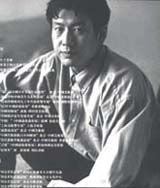
November 2002
Zhou
represents the new generation of painters coming out of China today.
He is already established in Asia and in the US as one of his country´s
finest artists.
In
2002 he will show us his recent paintings in Gallery 3,14, followed by
a Scandinavian tour of his works.
Zhou hosted one of the workshops at Dokumenta in Kassel in June 2001,
and we are very pleased that he has chosen 3,14 as his Scandinavian partners.
ZHOU CHUNYA, CHINESE PAINTER, A PROJECT FOR 2002
Heading
Neither West Nor East
By Jonathan Goodman
Asked whether he is a Chinese artist, the Chengdu-based painter Zhou Chunya asserts a qualified affirmative: "Even though Western art dominates my painting style, I would say I am a Chinese painter anywhere I go, because I maintain a Chinese lifestyle within myself." Zhou´s art demonstrates a similar dichotomy; his paintings reflect a dual grounding, in which the events of his life in China, or such traditionally Chinese subjects as rocks and flowers, are portrayed with a vigorous, oil-on-canvas expressionism, characteristic of Western rather than Asian art. For a man of Zhou´s achievement, who now finds himself in midcareer, complex allegiances, inherent to both his painting style and way of thinking, have a way of coming to the forefront in the discussion of his art.
His wary acknowledgment of the intricacies of his position as a contemporary Chinese artist, with both knowledge of and actual experience in the West, makes him a painter of extended reference and metaphorical possibility in a time which has tended toward.literal meaning in painting. Zhou´s style evidences a thoroughgoing understanding of Western, or more particularly German, neo-expressionism, its strong allegiance to feeling as well as its characteristically brushy hand. But the key to grasping his achievement lies as much in understanding why as in elucidating how a Chinese artist would make paintings such as his. It has been said that oil painting, a Western genre, has existed for a century in China--the same length of time in which, Zhou has suggested, traditional Chinese painting has suffered from a lack of creativity. This may, or may not, be true; the point is that Zhou has felt the need to look beyond the confines of his own culture for the stylistic and thematic freedom which remains central to his sensibility.
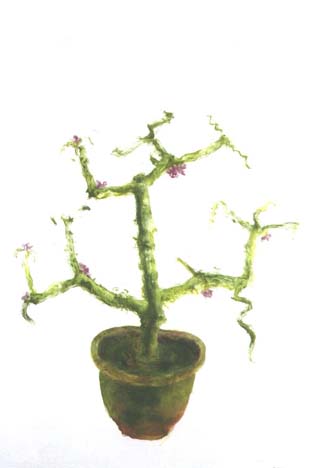
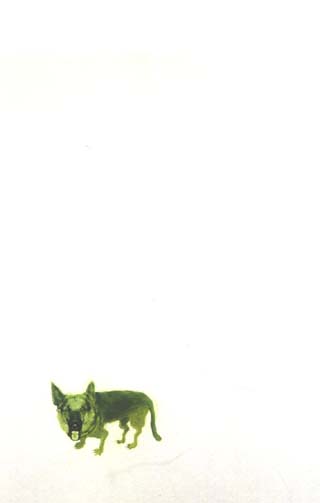
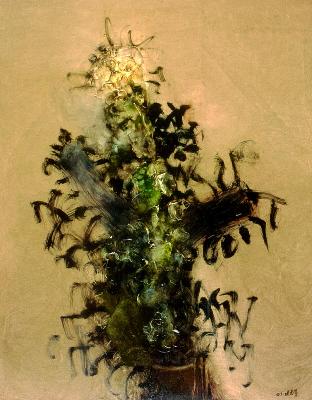 But
even so, even if the viewer accepts the possibility that traditional Chinese
painting is now in need of energy, that circumstance would not necessarily
demand that an artist turn to the West. Nor would it inevitably result that
a painter would, or should, reject his experience as a Chinese artist in
favor of a Westernized--that is to say, avant-garde--subject matter or method.
Zhou´s themes, generally speaking, do not turn away from Chinese experience;
instead, they reprise, under the guise of Western figuration, an existence
whose particulars link him to issues which call up reference to broad and
long Chinese art traditions. He is not rebelling or evading so much as strengthening
his position as a Chinese artist when he returns to Chinese subject matter
via a Western, expressionist hand. While there is in Zhou´s work the
inevitable tension that occurs in his incorporation of double, perhaps deliberately
opposed traditions, there is also in his art the evidence of something else--a
painterly, impartially practiced humanism which includes Asian and Western
elements in both the way he thinks and the way he paints.
But
even so, even if the viewer accepts the possibility that traditional Chinese
painting is now in need of energy, that circumstance would not necessarily
demand that an artist turn to the West. Nor would it inevitably result that
a painter would, or should, reject his experience as a Chinese artist in
favor of a Westernized--that is to say, avant-garde--subject matter or method.
Zhou´s themes, generally speaking, do not turn away from Chinese experience;
instead, they reprise, under the guise of Western figuration, an existence
whose particulars link him to issues which call up reference to broad and
long Chinese art traditions. He is not rebelling or evading so much as strengthening
his position as a Chinese artist when he returns to Chinese subject matter
via a Western, expressionist hand. While there is in Zhou´s work the
inevitable tension that occurs in his incorporation of double, perhaps deliberately
opposed traditions, there is also in his art the evidence of something else--a
painterly, impartially practiced humanism which includes Asian and Western
elements in both the way he thinks and the way he paints.
Zhou´s evenhandedness in making use of different pasts is possible now because he lives in a time when his experience, schooling, and imageries can be fluently conflated. Zhou is both serious and honest when he says, in regard to his artistic evolution, "I intended to have a new way, in I which I was heading neither West nor East. Note that the comment is expressed as a negation. If there is in fact a third way or space, it appears that, at least for Zhou, the new path is characterized by a refusal to accommodate neither the Chinese aspects of his lived experience nor the Western implications of his chosen style. At the same time, it may also be correct to see Zhou´s efforts as implying, in addition to a grand rejection, an equally grand endorsement--of the artist´s right to individualize the particulars of his or her life, in such a way that boundaries of culture and style fall to the wayside. Because Zhou is primarily interested in self-expression, and because the time allows him to read his experience as individually marked rather than culturally bound, we can see his art as asserting individual integrity rather than expressing the viewpoint of a Mainland Chinese artist. Zhou is very much aware of his situation, and so he presents his recognition as a denial, which in the long run creates the imaginative space he needs for his art. One recognizes that Zhou´s dilemma stems from biographical experience. Zhou came from a family that was both intellectual and political: his father was a literary critic, a Communist intellectual, while his mother followed the Communists to Si Chuan from Shanghai, eventually becoming a Communist party staff member in a school.
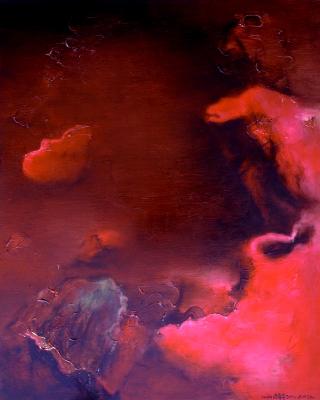
Even so, Zhou says, "I grew up in a musical, academic, and literary environment, but somehow I did not become a writer or musician." Encouraged by his father to draw, Zhou began to think seriously about becoming an artist when he was 16 years old. In the art school he attended while a teenager, he did not take an interest in Chinese traditional painting; instead, he was fascinated by color and sketching, and so he decided to study Western art, which at that time meant taking up the techniques of Russian oil painting. According to Zhou, he was taught the rules--the principles of anatomy, perspective, and chiaroscuro--from a Russian point of view: "Our artists told us how to depict objects by colors." He describes himself as ambitious and naive, commenting, "I wanted to become the best artist in the world--although what the world was, I had no idea." He spent a year in the Chengdu Library, reading all he could about Western, or rather Russian, art, the only volumes then available. Inevitably, his favorite artists were Russian heroes of the people such as Solikeve and Libin. It was only much later that he learned about artists in the canon of Western modernism: Monet, Matisse, van Gogh, and Picasso.
While a student at the Si Chuan Academy in Chong Ching, from 1978 to 1982, Zhou´s perspective began to change, not least because of concurrent shifts in Chinese society. It was then that Western art became more available; Zhou´s experience of Western-style artwork in prints caused him to turn his interests toward expressionism: "I discovered the strong expression that color can present."
At that point he abandoned a realist approach to painting. In 1986, four years after graduating from the Si Chuan Academy, Zhou went to Kassel, Germany, where he received a master´s degree in art from the Gesamthochschule. He plays down his training there, saying that "the classrooms where I really studied were the art museums and galleries of Germany and other European countries." The most important aspect of his education in Germany was his recognition of the achievements of neo-expressionism, which he sees as "exciting and stimulating," especially when he compares it with the earlier accomplishments of the German expressionists, which seem to him "weaker." The point is that Germany opened his eyes to possibilities; as Zhou remarks, "The art world has grown larger and more provoking as a result."
In consequence of his enthusiasm, neo-expressionism would become the hallmark of his adult style; Zhou acknowledges that the German neo- expressionists, such as Anselm Kiefer, Georg Baselitz, and A.R. Penck, heavily influenced him: "Their works are expressive and stimulating and yet have deep traditional roots." At the same time, however, Zhou never completely internalized Western esthetics. When first developing his style in the mid-1980s, a time when Zhou was influenced by Impressionism, he chose Tibetan characters and landscapes, because, as he says, "the subjects and colors were suitable and powerful."
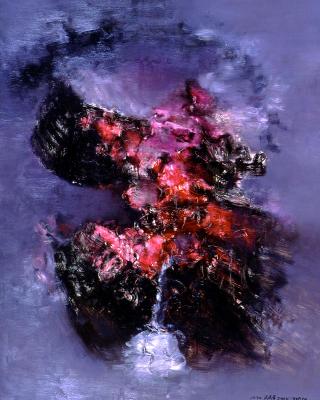 The
artist appears to travel back and forth between allegiances; he claims
that even as a student he was never really taken by configuration or narration
popular in China at the time: "My first artistic style was a kind
of alternative art in China already." On returning from Germany,
he focused on Chinese traditional art and also on Chinese classical esthetics.Traditional
Chinese music played a major role in the artist´s development and
even resulted in a major life decision; a tape of Chinese classical music,
sent to Zhou from China by musician friends, summoned such strong nostalgia--"The
complex, contradictory, and sentimental feelings evoked by ´The
Song Beyond the Great Wall´ affected me deeply"--that he ended
up dissuading the musicians from visiting Germany and decided himself
to go home to Chengdu in 1989. When Zhou returned to China, he also returned
to Chinese art: "Back in China, I systematically commenced studying
traditional Chinese painting, and began to utilize Chinese elements in
my work." This occurred primarily because Zhou felt that he had internalized
the atmosphere of Europe, and so he believed that at this point it was
necessary to return to Asian pictorial and thematic values. "Stone
Series" and "Floral Series," two groups of paintings begun
in 1990, very deliberately support the idea of Chinese painting--even
though they are worked up in a style which has nothing to do with traditional
Chinese art. Zhou´s "new way," in which style and content
do not reflect each other so much as they improvisatorily devise an intricate
dance around difference, may not at first appear very avant-garde; however,
it remains true that the struggle to meld painting styles is also an attempt
to join cultures--a progressive approach to art.
The
artist appears to travel back and forth between allegiances; he claims
that even as a student he was never really taken by configuration or narration
popular in China at the time: "My first artistic style was a kind
of alternative art in China already." On returning from Germany,
he focused on Chinese traditional art and also on Chinese classical esthetics.Traditional
Chinese music played a major role in the artist´s development and
even resulted in a major life decision; a tape of Chinese classical music,
sent to Zhou from China by musician friends, summoned such strong nostalgia--"The
complex, contradictory, and sentimental feelings evoked by ´The
Song Beyond the Great Wall´ affected me deeply"--that he ended
up dissuading the musicians from visiting Germany and decided himself
to go home to Chengdu in 1989. When Zhou returned to China, he also returned
to Chinese art: "Back in China, I systematically commenced studying
traditional Chinese painting, and began to utilize Chinese elements in
my work." This occurred primarily because Zhou felt that he had internalized
the atmosphere of Europe, and so he believed that at this point it was
necessary to return to Asian pictorial and thematic values. "Stone
Series" and "Floral Series," two groups of paintings begun
in 1990, very deliberately support the idea of Chinese painting--even
though they are worked up in a style which has nothing to do with traditional
Chinese art. Zhou´s "new way," in which style and content
do not reflect each other so much as they improvisatorily devise an intricate
dance around difference, may not at first appear very avant-garde; however,
it remains true that the struggle to meld painting styles is also an attempt
to join cultures--a progressive approach to art.
No easy bridge exists between Chinese tradition and neo-expressionism, and consequently, even so seemingly simple a choice as to render in oil classically Chinese imageries, such as flowers and rocks, becomes demonstrative of an element of mental toughness, even rebellion. Beginning in 1990, Zhou began work on two groups of paintings, entitled the "Stone Series" and the "Floral Series." In both, the artist begins with an iconography which makes perfect sense within the tradition of Chinese painting, but with an important difference in style: Zhou renders the images with a brushy, broadly expressionist hand.
As a result, the traditional categories of rocks and flowers are set up in the new light of a Western painting technique. Much of the immediacy and power in the two series stem from the vivid use of color; in the red rock sequence in particular, Zhou starts with a traditionally Chinese imagery and explodes the sense of the past by making use of a heavily impastoed red, which, even as the artist acknowledges the centrality of the color in Chinese cultural and political history, moves beyond historical associations to assert the primacy of color alone. As Zhou says, "Red is public, stout, explosive, and provoking." It may not be possible to divest the color red of its Chinese associations, but in a number of ways in these paintings, Zhou works toward an assertion of hue alone. In major ways, the "Stone Series" has taken Zhou away from the particulars of his birth, toward an internationalized idiom which reinvents Chinese art from the vantage point of Western expressionism. In two epic-size canvases from 1999, Zhou has painted what can best be understood as a monumental landscape through the heroic treatment of his red stones.
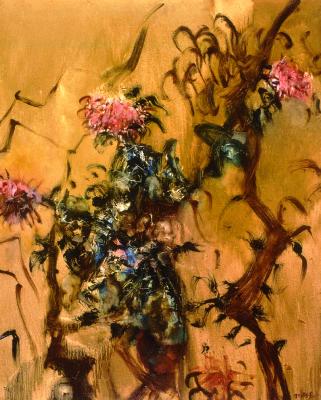
Zhou has commented on the role of the stone in Chinese art: "I have often wondered why stones are in so many traditional Chinese paintings. Perhaps the stone is a symbol of nature, their staunch solidity and texture having made them the emblem of the artistic spirit and technical method." Recognizing the historical importance of the stone as symbolic theme, Zhou proceeds both to quote that history and revivify it: "I paint red stones, give them life, spirit, and extended power. When drawing red stones, I prefer to do it spontaneously. I often cut stones with thin black lines and spontaneously decide whether the line will be dense or light, move up or down. The procedure is loose, improvisatory." In the paintings from 1999, the clouds, roughly blocked out with thick black lines, appear to hover in mid-air, against a grayish background sometimes lightened by white. The stone themselves are a messy affair, with patches of red paint brightened by underlayers of white. The paint´s thickness results in a complicated surface, with ridges, overlaps, and drips which spill out and over onto the equally complex black lines and patches defining the stones´ borders. The background is atmospheric, less heavily painted over, so that one has the impression of a mass of rocks floating in a mist, a very traditional Chinese subject.
Yet, even so, one´s initial and final impression of the rock series is that Zhou wants to reimagine what all too easily becomes a cliche in contemporary Chinese art; the vigor of his brush very deliberately destroys the subtle nuances of traditional Chinese painting, whose refined expressiveness cannot stand up to Zhou´s sense of art what should be now. While Zhou considers his "Floral" paintings a lesser part of his work--they are, he says, a "release and relaxation to me"--he also sees the timeless aspect of the theme: "Flowers are eternal subjects for all artists, maybe because the beauty of nature is so irresistible. So many artists embrace flowers. We photograph them, we paint them; green flowers remind me of everything that is classic." Seen in this way, Zhou´s subject carries considerable resonance; as the artist paints flowers, he both brings his personal enjoyment of painting to the fore and participates in art´s ongoing appreciation of the natural world.
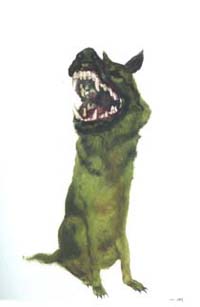
Of course, Chinese artists in particular have been drawn to the portrayal of nature, and so once again Zhou takes his place within his tradition, even as he paints in a way that is outside that tradition. For all the delicacy of his theme, Zhou renders his flowers with the same thick applications of paint he uses to paint his red rocks. One work from 1995 describes pinkish-red peonies which break away from a mass of black branches and blue flowers; in the background, dark strokes simply elaborate a mountain range over a tannish-brown ground. There is a tremendous sense of activity in the painting; the branches supporting the peonies are angled sharply and zigzag vertically, a movement echoed horizontally in the V-shaped strokes delineating the mountains. In the center of the composition the thick entanglement of black and blue acts as a nexus of energy; the work´s other components frame the central mass. In a painting like this, or in another work from 1995, in which a sunflower rises like a crown from a thick, trunklike vertical with short rounded arms with looped leaves, a traditional category of image gives way to the idea that paint is most expressive when considered a sign of physical activity. In Zhou´s rough, brushed treatment of established genres of imagery, the boundaries created by cultural time are broken by the energies of the paint itself.
In some ways, this connects with traditional Chinese painting, in which individual marks maintain interest even as they support a larger compositional structure; however, there is also a difference: the ferocity of Zhou´s actions places his art very much in our time--no sense of the pastoral can be found in his intensely expressed art. What Zhou has done is to shift one tradition onto the rails of another, and, in the violence of this transition, come up with an art whose compelling energies stem from the switch. Zhou´s most recent sequence of paintings, entitled the "Green Dog" series, comprise large canvases (250 x 200 cm) in which a monstrous German shepherd, painted green, rises up on his hind legs to dominate a grayish-brown landscape populated by rough, quick sketches of figures.
The series is autobiographical in origin--Zhou had a German shepherd as a pet until fairly recently, when the animal died, and he inserts himself, often in erotic embrace, into the scenarios he paints around the green dog. The impression one gets, on viewing the works, is very much that of a Western artist commenting on his life and loves--under the watchful eye of a huge dog, who becomes a tremendous sign. By far the most powerful impact in these paintings are made by the green dog, whom Zhou describes as follows: "´Green Dog´" is a symbol, an emblem... The color green is quiet, romantic, and lyric, and it contains in it the tranquility right before an explosion." In conversation, Zhou asserts that for the Chinese, the most important question is relations among people; the "Green Dog" paintings allow him to comment on such relationships.
It seems clear that the green dog functions as a symbolic projection of the artist himself--in the form of a more than slightly menacing, more than slightly humorous outpouring of energy and belligerence which has taken the shape of an animal. The German shepherd´s essentially aggressive nature is very much part of the image; in each painting, the dog´s mouth is always fully open, revealing a pair of formidable canine teeth in his lower jaw. While Zhou has made it clear, more than once, that if the form of his art is Western, the content is Chinese, in these works he appears to have moved into an internationalized idiom which emphasizes the individual over his or her affiliations with an originating culture.
For the Westerner, it is hard to remark a specifically Chinese content in this group of works; the only clue to Zheng´s background as a Chinese artist is found in the people portrayed to the side of the dog: their features are almost always Chinese. In Green Dog 4 (1997), as in the other examples in the series, the animal splits the canvas, standing on its back legs and moving up and into nearly the top of the painting.
Most of the background is taken up by a gray, washed-out sky, but up front, on the right of the painting, a naked Zhou grimaces at the viewer while locked in an embrace with a nude, smirking girl. On the painting´s left one sees the taishu, or scholar´s rocks--the eccentrically shaped limestone forms which are collected and are often seen in Chinese painting. The upright animal, which gives the scene its atmosphere of sexualized aggression, appears to stand guard and protect Zhou´s pleasure, which is depicted as grotesque. It is not hard to read the painting as an assertion of primal energies; viewers are inevitably drawn to the green dog, whose height attains nearly eight feet. In the other examples of the "Green Dog" series, a similar composition obtains. Nudity regularly occurs, as does the portrayal of sex. In Green Dog 2, for example, a woman licks the chest of a naked man; the couple dwarf the small figures in the lake in which they stand. On the left, a dressed man stumbles over a nude on her back, her legs widely parted to display and emphasize her sex. In the distance, on the horizon line, are two groups of mountains.
The image of a luminously green dog overseeing the erotic activities of its author and other possesses a farcical aspect, but by far the intimation is that of unleashed energy--an ungoverned id which both allows and enables the people in the paintings to seek pleasure. Even so, there is something macabre about the goings on; the faces of the paintings´ inhabitants regularly leer, mock, and sneer at their audience. Their self-involved attitude is not so far from that seen in the art of the German expressionists early in the twentieth century; passion and drive and a certain absurdity are paramount. These powerful paintings place Zhou in a bit of a dilemma.
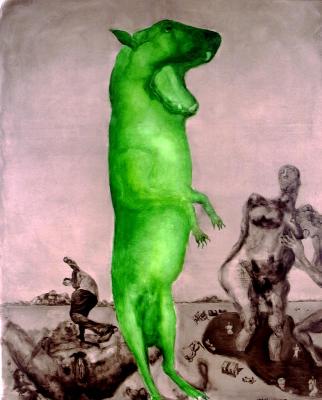
They are international in style and address an international audience; however, Zhou continues to view himself as a Chinese painter, one who carries within his sensibility a profound attachment to China. But then, he has also said, "I have spoken about the differences between Eastern and Western cultures; I kind of like such dichotomy and would like to retain it in me." Zhou´s doubling back on his assertion that he remains in essence a Chinese painter doesn´t undermine his feeling, either within himself or within his art. What the double stance means is that while one may see oneself in one manner or another, the conflation of two traditions as powerful and compelling as that of China and that of the West encourages an either-or treatment of identity. Zhou is right to see this as a situation of unusual intricacy: "Chinese people´s minds are always complicated and contradictory, and I cherish this.
Complexity of this kind is hardly to be found in modern Western pragmatic societies. The art world will be enormously enriched if we can put those complex ideas into it." True enough. But the sensuousness of the application of paint, along with the sensuality of action, seen in Zhou´s art argues for an eroticized perception, in which cultural and stylistic complexity are pretty well overwhelmed by a towering green dog. The dog transcends the complexity Zhou describes so well; it rises up against the sky as a statement countering dichotomy. It is its own assertion of power, leading to the unknown.
Zhou, when asked about his plans for the future, replies, "I will plunge into the subject of humanity. I am an artist of change....I am one who likes risk, likes to encounter unexpected matters. It is part of my life." What Zhou has done is to take the geographical, thematic, and stylistic juxtapositions of his life and pass comment on their existential complexity in his paintings, which may have their origins in a sense of convolutedness but which for all that make their statement as passion.
Although Zhou´s expressiveness as an artist may well be, as he asserts generally about Chinese mind, "contradictory"; on another level, it provides him with a direct and impassioned way out of his dilemma. He knows, in the same way most strong artists have known in the twentieth century, that paintings establishes contacts--between art and life, between cultures and times--which finally prove as mysterious as they are moving.